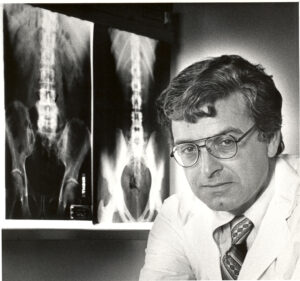
Washington University School of Medicine in St. Louis and Barnes-Jewish Hospital share a long tradition of excellence in musculoskeletal research and patient care.
The Division of Bone and Mineral Diseases has its roots in the former Jewish Hospital of St. Louis, where the foresight, leadership, and pioneering work of the late Louis V. Avioli, MD, one of the founding fathers of the field of bone and mineral diseases, laid the foundation of a unique, world-class center for research, training, and patient care dedicated to disorders of mineral and skeletal homeostasis.
Louis V. Avioli, MD
A graduate of Princeton and Yale Universities, Avioli came to St. Louis in 1966 to lead the Division of Endocrinology at Jewish Hospital, a smaller teaching facility compared to its “sister” Barnes Hospital.
Avioli’s research focused on the causes of bone loss in postmenopausal women and the elderly, and in these early and pioneering years, he contributed to clarify the role of vitamin D in regulating calcium metabolism.
With his early trainees, Drs. Stanley Birge, Lewis Chase, John Haddad, and Theodore Hahn, Avioli discovered the importance of key vitamin D metabolites in regulating intestinal calcium absorption and bone mineralization; recognized the negative effects of antiepileptics, in particular barbiturates, on vitamin D metabolism; and established the first radio-competitive methods to measure 25-hydroxy vitamin D in the blood, an assay that became the mainstay diagnostic test for vitamin D status.
A new division
The strong focus on metabolic bone disorders by the Jewish Hospital endocrinologists and their highly successful, pioneering clinical research led the Department of Medicine to establish, in 1975, a new Division of Endocrinology and Bone and Mineral Metabolism at Jewish Hospital under Avioli’s leadership.
Training new leaders
The nineteen-seventies were times of fast growth and seminal discoveries in this field, and the newly formed division distinguished itself with important scientific contributions as well as a premier training center for physicians and researchers interested in this new field.
It was in these times that an NIH-sponsored training program in “Mineral and Skeletal Metabolism” was conceived and established by Avioli as the backbone for educating students, residents, and fellows in this new discipline.
This training program is an example of extraordinary success in teaching. In its three decades of continuous funding, it trained over 100 individuals, the majority of whom have pursued academic careers. Many of the current leaders in the field of metabolic bone diseases have been trained at Washington University School of Medicine.
Fundamental research
One of the fundamental observations by the division’s young investigators, and in particular Michael Whyte, MD, and Steven Teitelbaum, MD, was that postmenopausal osteoporosis was a heterogeneous disorder, characterized by forms with high, normal, or low bone turnover, thus laying the bases for a new pathophysiological classification of the disease.

These inroads were made possible by the development of new bone histomorphometric methods that allowed the assessment of bone cell activity in bone biopsies.
In those years, William Peck, MD, then Physician-in-Chief of Jewish Hospital and later Dean of the Medical School was also an active member of the “bone group” at Washington University, and already an authority in osteoporosis. His laboratory would be the first to establish and utilize the calvaria cell culture model to elucidate the steps of the osteoblast differentiation program.